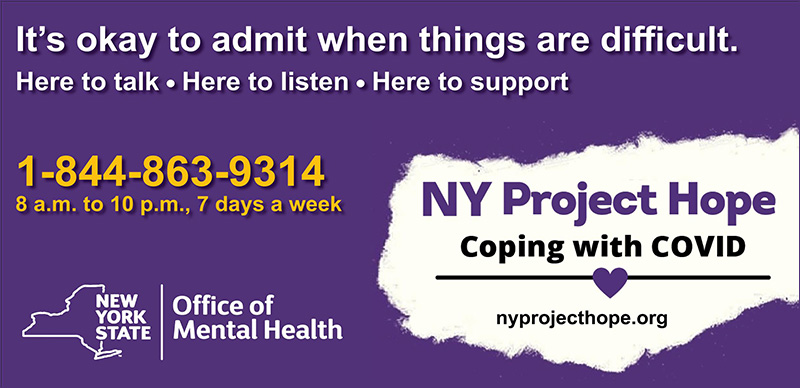A traumatic experience can have long-lasting effects on a person’s physical, mental and emotional health and well-being for decades afterwards; and the more traumatic events a person experiences, the more likely they’ll have significant medical and emotional problems.

Ann Sullivan, MD
Commissioner, NYS OMH
For the past 18 months, we’ve all shared in the trauma of the COVID-19 pandemic, which has disrupted our schools and daily lives, brought our economy to a halt, and taken the lives of friends, colleagues and loved ones.
Even before the pandemic, we’d seen an increase in awareness of how prevalent other types of trauma are, as well as the resultant psychological distress, mental illness, and substance abuse. Studies over the past two decades show that a vast majority of people seeking treatment for mental health issues and substance abuse disorders were exposed to significant emotional, physical, and or sexual abuse in childhood:
- The U.S Centers for Disease Control (CDC) report that one in four children experiences some sort of maltreatment – defined as physical, sexual, or emotional abuse;
- One in four women have experienced domestic violence; and,
- One in five women and one in 71 men have experienced rape at some point in their lives – 12 percent of these women and 30 percent of the men were younger than 10 years old when they were raped.
Research has indicated that a majority of youth and young adults seeking help have experienced some level of trauma in their lives but have often been reluctant to talk about it. In addition, until recently, many models of care weren’t prepared to address this issue.
After a traumatic event, one may experience shock or denial, which, in turn, can lead to sadness, anger, and guilt as the past intrudes into the present. People with trauma histories often use maladaptive coping mechanisms to help alleviate the psychic pain they are experiencing. Common examples are using drugs and alcohol, risk taking, over or undereating and engaging in self harm, such as cutting or burning. Survivors often express mixed feelings about dealing with trauma, even if they’re fully aware of its impact. They may avoid revisiting their pasts or other potential therapy out of fear of experiencing distress again.
Trauma and the COVID Pandemic
Trauma has touched all our lives, in some manner, because of the pandemic. Many of us are still grieving the death of friends or family members and are experiencing the anger and sadness that can often accompany such loss. This trauma of losing a loved one is particularly difficult for children, many of whom are also struggling with how to handle the confusion, and uncertainty of returning to school after months of social isolation.
Recent research is confirming what every parent has suspected – and witnessed – during the last 18 months: that children and adolescents are probably more likely to experience high rates of depression and anxiety during and after social isolation. The research recommends that clinical services offer preventive support and early intervention where possible and be prepared for an increase in mental health problems.
Of course, isolation also affected older adults, who benefit greatly from social interaction but are often denied the opportunity to meet and talk with others under the best of circumstance. The pandemic made social interaction even more difficult, and potentially dangerous, for the elderly.
But no group was more traumatized by the virus than our first responders and health care personnel, many of whom experienced grief and despair as they lost patients and colleagues to the virus.
Respecting an Individual’s Experience
The pandemic underscored the need for trauma-informed care, a system of practice that operates on the belief that services must be developed with the individual’s perspective in mind. It recognizes that a survivor’s perception of events plays a central role. This approach to care seeks to treat the whole person and address the past traumas that may have influenced an individual’s sense of self and hindered their ability to connect with others and make use of support services.
Rather than applying a general approach to treatment, trauma-informed care focuses on each person as an individual. It recognizes that it is vital for each individual to participate in the development, delivery, and evaluation of services.
Precise care is taken to anticipate and avoid institutional processes and practices that could retraumatize a survivor. It shifts the focus from, “What is wrong with you?” to, “What has happened to you? What has worked for you?” Such use of language and choice of words can set the tone for recovery. Therefore, it encourages avoiding the term “victim” and using “survivor” instead.
Trauma-informed practice places importance on helping a survivor understand that their trauma is a normal reaction to a situation that was anything but. It helps them understand that their responses and behaviors often originate from a need to adapt as a means of coping.
More mental health practices are using trauma-informed care and are incorporating universal routine screenings for trauma and take notice of clients’ past traumatic experiences. They are also taking steps to examine their own treatment strategies, program procedures, and organizational polices, to evaluate whether they could cause distress. Programs are incorporating peer support services, which reinforce the message that a provider–consumer partnership is important. They’re shifting their perspective from, “we, the providers, know best” to “together, we can find solutions.”
A successful program can help an individual overcome their personal obstacles to developing a strong, healthy relationship with their provider and more fully taking part in their treatment. Incorporating trauma-informed practice can help to improve individual care by more effectively engaging individuals and helping them stay in treatment.
Promoting and Expanding the Use of Trauma Informed Care
According to the CDC, developing a trauma-informed approach “is not accomplished through any single particular technique or checklist. It requires constant attention, caring awareness, sensitivity, and possibly a cultural change at an organizational level. On-going internal organizational assessment and quality improvement, as well as engagement with community stakeholders, will help to imbed this approach which can be augmented with organizational development and practice improvement.”
To help expand the use of trauma informed care, the New York State Office of Mental Health, together with Coordinated Care Services, Inc., provides funding for the NYS Trauma Informed Network, a collaboration of individuals, caregivers, professionals, and organizations dedicated to enhancing trauma-responsive practice change throughout the state.
The Network enhances communication and encourages collaboration and sharing of resources among agencies implementing trauma-informed practices. The organization’s website allows “…individuals and organizations to connect to one another, share training or event information, and to easily obtain resources to enhance their own work in becoming more trauma-responsive.” For more information visit: www.traumainformedny.org.
As we recover from the COVID-19 pandemic, the importance of, and need for, trauma informed care, has never been clearer. Fortunately, more and more healthcare providers are integrating knowledge about trauma into their treatment practice, policies, and procedures. This helps individuals who have experienced trauma to be validated, supported and empowered ultimately providing better health outcomes.
Ann Sullivan, MD, is Commissioner of the NYS Office of Mental Health (OMH).








[…] higher rates of depression and anxiety during and after the shutdown and social isolation.1 The pandemic revealed the strong need for caring for the whole person and implementing informed […]